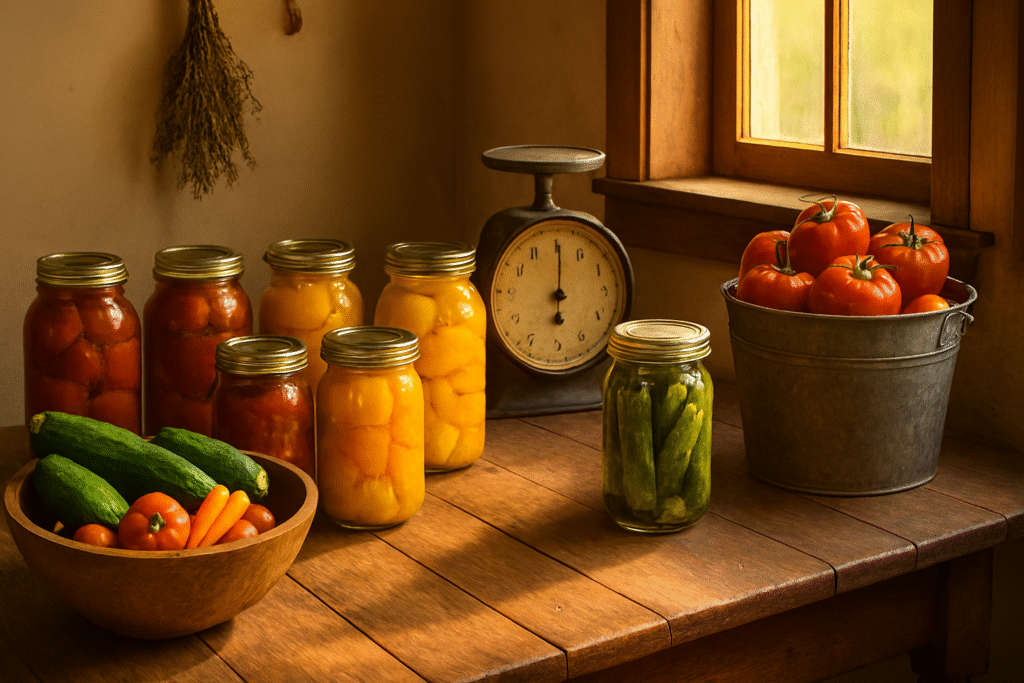Introduction

You’ve tilled, planted, watered, and wrestled cucumbers the size of baseball bats from the garden (don’t worry, it happens to the best of us). Now the pantry is overflowing, the fridge is stuffed, and you’re wondering if the neighbors are avoiding eye contact to dodge your “Want some zucchini?” question.
It’s time to talk about preserving the harvest — the magical process of turning that seasonal bounty into year-round deliciousness. Whether you want to line your pantry with mason jars, fill your freezer to the brim, or ferment your way into sauerkraut glory, there’s a method for every taste and every tomato.
Why Preserve Your Harvest?
- Save Money: Store-bought salsa is fine… until you realize you could have made it for half the price from your own tomatoes.
- Reduce Waste: No more guilt over forgotten cucumbers at the bottom of the crisper drawer.
- Flavor Control: You choose the seasoning, the salt, the spice level, and whether or not “extra garlic” means half a bulb or three whole bulbs.
- Self-Reliance: It’s deeply satisfying to walk into your kitchen in January and grab a jar of home-canned peaches when there’s snow on the ground.
Popular Preservation Methods
1. Canning (Water Bath & Pressure Canning)
Best For: Tomatoes, jams, pickles, green beans, soups, broths.
Canning is like the superhero of preservation — your food is shelf-stable for years. There are two main methods:
- Water Bath Canning: For high-acid foods like tomatoes, fruits, and pickles.
- Pressure Canning: For low-acid foods like meats, beans, and most vegetables.
Pro Tip: Don’t “wing it” with canning recipes. Food safety matters, and botulism is not the kind of spice you want in your soup.
Recommended Products:
- Ball Complete Book of Home Preserving – Your go-to canning bible.
- Presto 23-Quart Pressure Canner – Big enough for large batches.
- Ball Mason Jars (Wide Mouth) – Easier to fill and clean.
2. Freezing
Best For: Berries, corn, greens, soups, sauces.
Freezing is the lazy gardener’s best friend — it’s quick, easy, and keeps food fresh-tasting. The trick is to blanch vegetables before freezing to preserve flavor and texture.
Pro Tip: Freeze things on a baking sheet first, then bag them. This keeps your peas from turning into a solid, frozen green brick.
Recommended Products:
- FoodSaver Vacuum Sealer – Extends freezer life and prevents freezer burn.
- Heavy-Duty Freezer Bags – Don’t skimp here, or you’ll regret it.
- OXO Good Grips Freezer-Safe Containers – Perfect for soups and sauces.
3. Dehydrating
Best For: Herbs, apple chips, tomatoes, jerky.
Dehydrating removes water from food so it lasts for months — and it’s great for turning surplus into snack food.
Pro Tip: Label your jars. Dried oregano and dried thyme look very similar… until you put oregano in your tea.
Recommended Products:
- Nesco Snackmaster Pro Dehydrator – Reliable, affordable, and expandable.
- Excalibur 9-Tray Dehydrator – For serious preservation enthusiasts.
- Silicone Dehydrator Sheets – For fruit leather and sticky foods.
4. Fermenting
Best For: Sauerkraut, kimchi, pickles, kombucha.
Fermentation uses beneficial bacteria to preserve food while boosting probiotics. It’s part science experiment, part magic, and 100% tasty.
Pro Tip: Always burp your fermenting jars unless you enjoy cleaning kraut juice off the ceiling.
Recommended Products:
- Kilner Fermentation Set – Great starter kit.
- Ball Fermentation Kit – Includes weights and airlocks.
- Morton Canning & Pickling Salt – Non-iodized for better fermentation.
5. Root Cellaring
Best For: Potatoes, carrots, onions, apples.
If you’ve got a cool, dark, and humid space, root cellaring is the oldest and most low-tech preservation method. Bonus: It’s also the most “Little House on the Prairie” you can get without actually moving to a cabin.
Pro Tip: Keep apples away from potatoes — apples emit ethylene gas, which can make potatoes sprout faster.
Recommended Products:
- Stackable Wooden Storage Bins – Keeps produce organized and ventilated.
- ThermoPro Hygrometer/Thermometer – Monitor humidity and temperature.
Extra Tips for Success
- Label everything with contents and date — future you will thank you.
- Keep an inventory so you know what’s left without having to rummage through everything.
- Start small and expand your preservation skills each year.
Final Thoughts
Preserving the harvest is like giving yourself a delicious, edible time machine — a way to relive summer’s flavors in the dead of winter. Whether you’re lining shelves with jars, filling freezers, or fermenting your way to probiotic glory, every jar, bag, and bin is a small victory in your homesteading journey.
And remember — if your first batch of pickles tastes more like salty cucumbers than the crunchy deli kind, that’s not failure, that’s “culinary character.”
